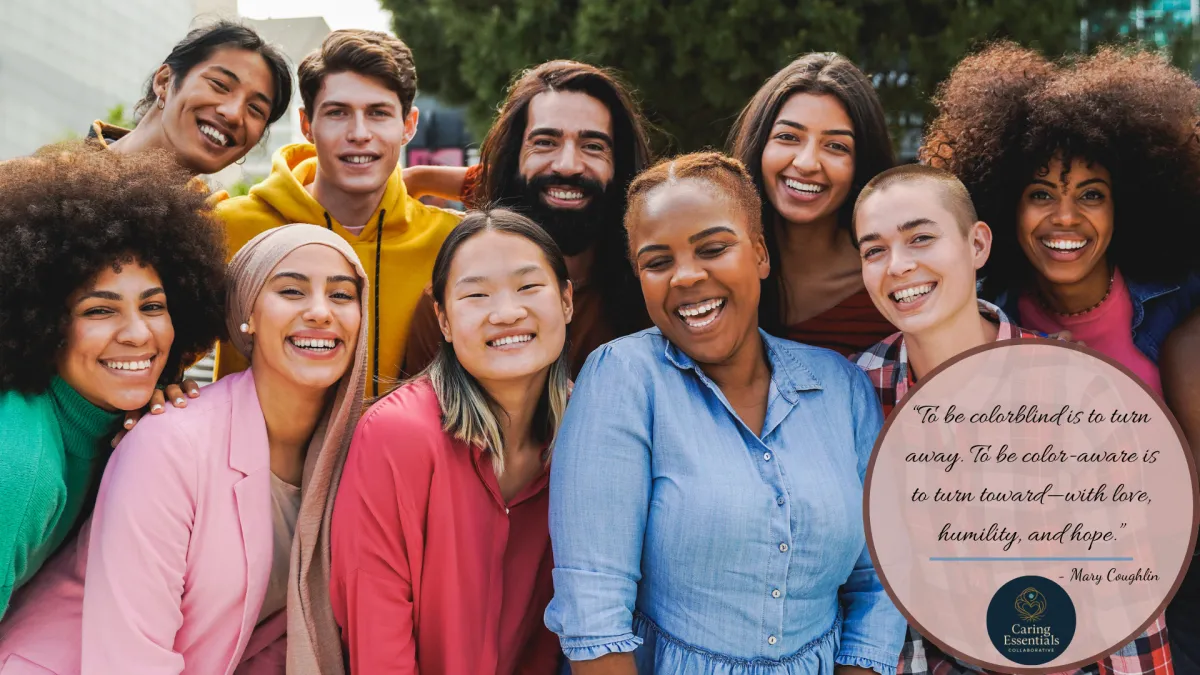
Seeing with the Heart: Why “Colorblindness” Isn’t Healing
“To be colorblind is to turn away. To be color-aware is to turn toward, with love, humility, and hope.” - Mary Coughlin
New Blog Post
The Origins of “Colorblindness”
Caring Science and Radical Seeing
From Colorblindness to Color Awareness
I’ve heard many people say, “I don’t see color.”
Usually, it’s said with kindness, with a hope to rise above racism, to treat everyone equally, to affirm that we are all human.
But the truth is: if I don’t see your color, I don’t see you.
I don’t see your story, your lineage, the histories that shaped you, or the realities you still navigate.
Colorblindness, even when born of good intent, becomes its own kind of blindness; a way of bypassing pain rather than healing it.
Trauma-informed care teaches us that healing happens through being seen, known, and valued. When we tell people we “don’t see color,” we unintentionally replicate the very invisibility that trauma creates.
The Origins of “Colorblindness”
The idea of colorblindness has a long and complicated history. In 1896, Supreme Court Justice John Marshall Harlan wrote in his dissent of Plessy v. Ferguson that the Constitution is “color-blind,” suggesting that equality requires ignoring race.
Decades later, during the Civil Rights Movement, the phrase took on moral weight. Many believed the dream of justice meant a world where skin color no longer defined opportunity, a vision of shared humanity.
But over time, this aspiration was twisted. “Colorblindness” became a shield used to deny the ongoing reality of racism. If we claim not to see color, we don’t have to see inequity either. What began as a promise of unity became a barrier to accountability.
A Trauma-Informed Lens
Trauma lives in the body, in our nervous systems, our bones, and in our collective story. It thrives in silence, shame, and invisibility. So when we choose to look away from someone’s lived reality—their color, their culture, their experience—we participate in that invisibility.
To be trauma-informed is to bear witness; to create safety through presence, not pretense.
The B.U.F.F.E.R. framework helps us translate that awareness into action:
Belonging: True belonging means all of you is welcome, including the parts shaped by history and heritage.
Understanding: Healing begins when we seek to understand, not to explain away.
Forgiveness: We must forgive ourselves for what we didn’t know, and stay open enough to learn.
Frameworks: Trauma-informed developmental care offers us a structure for awareness, equity, and compassion in practice.
Equanimity: Holding steady in discomfort is part of the work; turning toward truth without defensiveness is an act of love.
Respect: To respect someone is to recognize their whole self, their culture, color, and story, as sacred.
When we adopt a trauma-informed lens, we realize that “colorblindness” isn’t neutrality. It’s avoidance. Healing, on the other hand, asks us to see—clearly, courageously, and completely.
Caring Science and Radical Seeing
Jean Watson’s Caring Science reminds us that authentic presence requires seeing with the heart.
It invites us into sacred relationship, with self, with others, and with the human family.
“Caring is the ethical ideal of nursing,” Watson writes, “where we come to know the other as a whole and sacred being.”
In that spirit, to see color is to witness the wholeness of another person’s humanity.
It is to honor the beauty and the burden that come with their story.
It is to understand that love does not erase difference, it embraces it.
From Colorblindness to Color Awareness
To move beyond colorblindness, we don’t have to swing toward labeling or stereotyping. We can choose color awareness—a way of seeing that recognizes difference as a source of richness, not division. We can practice reflective seeing, noticing our reactions and assumptions. We can cultivate cultural humility, approaching others with curiosity instead of certainty. And we can build communities grounded in belonging, where no one has to disappear in order to be accepted.
To be “color-aware” is not to divide, it is to dignify. It is to say: I see you. I honor you. I celebrate you.
The Call to Conscious Belonging
Racism, in its many forms, is a trauma that fractures connection. The antidote is not blindness, but awareness; not sameness, but sacred difference held in love.
A trauma-informed, Caring Science–grounded society is one that embraces the full spectrum of humanity—the colors, textures, languages, and histories that make us who we are.
When we choose to see with the heart, we do not erase pain, we transform it into compassion.
We do not deny difference, we weave it into belonging.
Closing Reflection
Today, may we practice the art of seeing fully.
May we look beyond our comfort and into the truth of each other’s stories.
May we be brave enough to see color, not as a source of division, but as a sign of life.
And may we remember: healing doesn’t happen through blindness.
It happens through the courage to see—and love—what is real.
Take care and care well,
Mary
